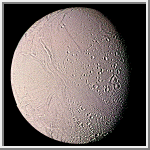 Enceladus
Enceladus Enceladus
EnceladusSaturn II

Enceladus [en-SELL-ah-dus] is one of the innermost moons of Saturn. It is quite similar in size to Mimas but has a smoother, brighter surface. Enceladus reflects almost 100 percent of the sunlight that strikes it. Unlike Mimas, Enceladus displays at least five different types of terrain. Parts of Enceladus shows craters no larger than 35 km in diameter. Other areas show regions with no craters indicating major resurfacing events in the geologically recent past. There are fissures, plains, corrugated terrain and other crustal deformations. All of this indicates that that interior of the moon may be liquid today, even though it should have frozen aeons ago. It is postulated that Enceladus is heated by a tidal mechanism similar to Jupiter's moon Io. It is perturbed in its orbit by Saturn's gravitational field and by the large neighboring satellites Tethys and Dione. Because Enceladus reflects so much sunlight, the surface temperature is only -201° C (-330° F).

Discovered by .............................. William Herschel Date of discovery ...................................... 1789 Mass (kg) .......................................... 8.40e+19 Mass (Earth = 1) ................................. 1.4056e-05 Equatorial radius (km) .................................. 250 Equatorial radius (Earth = 1) .................... 3.9197e-02 Mean density (gm/cm^3) ................................. 1.24 Mean distance from Saturn (km) ...................... 238,020 Rotational period (days) ........................... 1.370218 Orbital period (days) .............................. 1.370218 Mean orbital velocity (km/sec) ........................ 12.64 Orbital eccentricity ................................. 0.0045 Orbital inclination .................................... 0.02° Escape velocity (km/sec) .............................. 0.212 Visual geometric albedo ................................ 0.99 Mean surface temperature ............................. -201°C Magnitude (Vo) ......................................... 11.7

 Animation of Enceladus
Animation of Enceladus
 Enceladus
(GIF, 252K)
Enceladus
(GIF, 252K)
This Voyager 2 mosaic of Enceladus was made from images taken
through the clear, violet and green filters on August 25, 1981, from a
distance of 119,000 kilometers (74,000 miles). In many ways, the
surface of this satellite of Saturn resembles that of Jupiter's
Galilean satellite Ganymede. Enceladus, however, is only
one-tenth Ganymede's size. Some regions of Enceladus show impact
craters up to 35 kilometers (22 miles) in diameter, whereas other
areas are smooth and uncratered. Linear sets of grooves tens of
kilometers long traverse the surface and are probably
faults
resulting from deformation of the crust. The uncratered regions
are geologically young and suggest that Enceladus has experienced
a period of relatively recent internal melting. The rims of
several craters near the lower center of the picture have been
flooded by the smooth terrain. Features as small
as 2 kilometers (1.2 miles) are visible in this highest-resolution
view of Enceladus. (Courtesy NASA/JPL)

